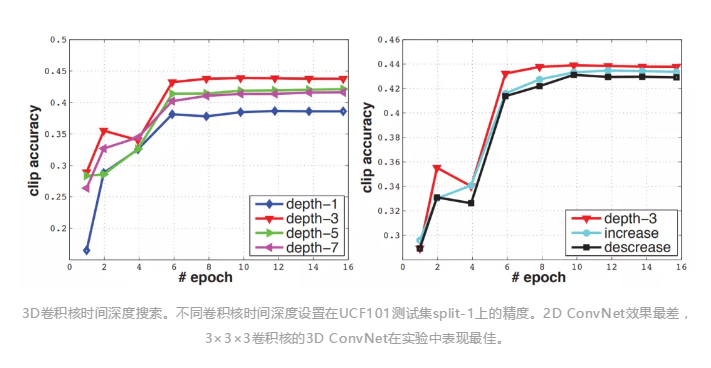1、3D卷积的简介
在图像处理领域,被卷积的都是静态图像,所以使用2D卷积网络就足以。而在视频理解领域,为了同时保留时序信息,就需要同时学习时空特征,如果用2DCNN来处理视频,那么将不能考虑编码在连续多帧之间的运动信息,而C3D网络就在这样的背景下横空出世了。
3D convolution 最早应该是在“3D convolutional neural networks for human action”中被提出并用于行为识别的。该论文提出的模型尝试从空间和时间维度中提取特征,从而捕获在多个相邻帧中编码的运动信息。
主要贡献如下:
1、我们提出应用3D卷积运算从视频数据中提取空间和时间特征以进行动作识别。这些3D特征提取器在空间和时间维度上操作,从而捕获视频流中的运动信息。
2、我们开发了基于3D卷积特征提取器的3D卷积神经网络架构。该CNN架构从相邻视频帧生成多个信息信道,并在每个信道中分别执行卷积和子采样。最终的特征表示是通过组合所有频道的信息获得的。
3、我们提出通过增加具有作为高级运动特征计算的辅助输出的模型来规范3D CNN模型。我们进一步提出通过组合各种不同架构的输出来提高3D CNN模型的性能。
具体操作:通过同时堆叠多个连续帧形成的立方体与一个3D核进行卷积。通过这个构建,卷积层上的特征图连接到了前一层的多个连续帧,从而捕捉动作信息。
2、C3D模型原理与PyTorch实现
2.1、C3D模型结构
3D ConvNets 更适合学习时空特征,通过3D卷积和3D池化,可以对时间信息建模,而2D卷积只能在空间上学习特征。3D和2D的区别如下:
2D卷积网络输入图像会产生图像,输入视频输出的也是图像,3D卷积网络输入视频会输出另外一个视频,保留输入的时间信息。
2D和3D卷积运算。a)在一个图像上应用2D卷积会产生一个图像。b)在视频卷上应用2D卷积(多个帧作为多个通道)也会产生一个图像。c)在视频卷上应用3D卷积可产生另一个卷,保留输入信号的时间信息。
3D卷积核时间深度搜索。不同卷积核时间深度设置在UCF101测试集split-1上的精度。2D ConvNet效果最差,3×3×3卷积核的3D ConvNet在实验中表现最佳。
结构如下图:
C3D架构。C3D网络有8个卷积层,5个最大池化层和2个全连接层,最后是softmax输出层。所有的3D卷积核都是3×3×3,在空间和时间上都有步长1。滤波器的数量表示在每个框中。3D池化层由pool1到pool5表示。所有池化核为2×2×2,除了pool1为1×2×2。每个全连接层有4096个输出单元。
网络架构:上图的发现表明,3×3×3卷积核的均匀设置是3D ConvNets的最佳选择。这个发现与2D ConvNets一致。使用大型数据集,可以根据机器内存限制和计算承受能力,尽可能深入地训练具有3×3×3核的3D ConvNet。使用目前的GPU内存,我们设计了3D ConvNet,具有8个卷积层、5个池化层、两个全连接层,以及一个softmax输出层。网络架构如图3所示。为了简单起见,我们从现在开始将这个网络称为C3D。所有3D卷积滤波器均为3×3×3,步长为1×1×1。为了保持早期的时间信息设置pool1核大小为1×2×2、步长1×2×2,其余所有3D池化层均为2×2×2,步长为2×2×2。每个全连接层有4096个输出单元。
import torch
import torch.nn as nn
from mypath import Path
class C3D(nn.Module):
"""
The C3D network.
"""
def __init__(self, num_classes, pretrained=False):
super(C3D, self).__init__()
self.conv1 = nn.Conv3d(3, 64, kernel_size=(3, 3, 3), padding=(1, 1, 1))
self.pool1 = nn.MaxPool3d(kernel_size=(1, 2, 2), stride=(1, 2, 2))
self.conv2 = nn.Conv3d(64, 128, kernel_size=(3, 3, 3), padding=(1, 1, 1))
self.pool2 = nn.MaxPool3d(kernel_size=(2, 2, 2), stride=(2, 2, 2))
self.conv3a = nn.Conv3d(128, 256, kernel_size=(3, 3, 3), padding=(1, 1, 1))
self.conv3b = nn.Conv3d(256, 256, kernel_size=(3, 3, 3), padding=(1, 1, 1))
self.pool3 = nn.MaxPool3d(kernel_size=(2, 2, 2), stride=(2, 2, 2))
self.conv4a = nn.Conv3d(256, 512, kernel_size=(3, 3, 3), padding=(1, 1, 1))
self.conv4b = nn.Conv3d(512, 512, kernel_size=(3, 3, 3), padding=(1, 1, 1))
self.pool4 = nn.MaxPool3d(kernel_size=(2, 2, 2), stride=(2, 2, 2))
self.conv5a = nn.Conv3d(512, 512, kernel_size=(3, 3, 3), padding=(1, 1, 1))
self.conv5b = nn.Conv3d(512, 512, kernel_size=(3, 3, 3), padding=(1, 1, 1))
self.pool5 = nn.MaxPool3d(kernel_size=(2, 2, 2), stride=(2, 2, 2), padding=(0, 1, 1))
self.fc6 = nn.Linear(8192, 4096)
self.fc7 = nn.Linear(4096, 4096)
self.fc8 = nn.Linear(4096, num_classes)
self.dropout = nn.Dropout(p=0.5)
self.relu = nn.ReLU()
self.__init_weight()
if pretrained:
self.__load_pretrained_weights()
def forward(self, x):
# print ('1:',x.size())
x = self.relu(self.conv1(x))
# print ('2:',x.size())
x = self.pool1(x)
# print ('3:',x.size())
x = self.relu(self.conv2(x))
# print ('4:',x.size())
x = self.pool2(x)
# print ('5:',x.size())
x = self.relu(self.conv3a(x))
# print ('6:',x.size())
x = self.relu(self.conv3b(x))
# print ('7:',x.size())
x = self.pool3(x)
# print ('8:',x.size())
x = self.relu(self.conv4a(x))
# print ('9:',x.size())
x = self.relu(self.conv4b(x))
# print ('10:',x.size())
x = self.pool4(x)
# print ('11:',x.size())
x = self.relu(self.conv5a(x))
# print ('12:',x.size())
x = self.relu(self.conv5b(x))
# print ('13:',x.size())
x = self.pool5(x)
# print ('14:',x.size())
x = x.view(-1, 8192)
# print ('15:',x.size())
x = self.relu(self.fc6(x))
# print ('16:',x.size())
x = self.dropout(x)
x = self.relu(self.fc7(x))
x = self.dropout(x)
logits = self.fc8(x)
# print ('17:',logits.size())
return logits
def __load_pretrained_weights(self):
"""Initialiaze network."""
corresp_name = {
# Conv1
"features.0.weight": "conv1.weight",
"features.0.bias": "conv1.bias",
# Conv2
"features.3.weight": "conv2.weight",
"features.3.bias": "conv2.bias",
# Conv3a
"features.6.weight": "conv3a.weight",
"features.6.bias": "conv3a.bias",
# Conv3b
"features.8.weight": "conv3b.weight",
"features.8.bias": "conv3b.bias",
# Conv4a
"features.11.weight": "conv4a.weight",
"features.11.bias": "conv4a.bias",
# Conv4b
"features.13.weight": "conv4b.weight",
"features.13.bias": "conv4b.bias",
# Conv5a
"features.16.weight": "conv5a.weight",
"features.16.bias": "conv5a.bias",
# Conv5b
"features.18.weight": "conv5b.weight",
"features.18.bias": "conv5b.bias",
# fc6
"classifier.0.weight": "fc6.weight",
"classifier.0.bias": "fc6.bias",
# fc7
"classifier.3.weight": "fc7.weight",
"classifier.3.bias": "fc7.bias",
}
p_dict = torch.load(Path.model_dir())
s_dict = self.state_dict()
for name in p_dict:
if name not in corresp_name:
continue
s_dict[corresp_name[name]] = p_dict[name]
self.load_state_dict(s_dict)
def __init_weight(self):
for m in self.modules():
if isinstance(m, nn.Conv3d):
# n = m.kernel_size[0] * m.kernel_size[1] * m.out_channels
# m.weight.data.normal_(0, math.sqrt(2. / n))
torch.nn.init.kaiming_normal_(m.weight)
elif isinstance(m, nn.BatchNorm3d):
m.weight.data.fill_(1)
m.bias.data.zero_()
def get_1x_lr_params(model):
"""
This generator returns all the parameters for conv and two fc layers of the net.
"""
b = [model.conv1, model.conv2, model.conv3a, model.conv3b, model.conv4a, model.conv4b,
model.conv5a, model.conv5b, model.fc6, model.fc7]
for i in range(len(b)):
for k in b[i].parameters():
if k.requires_grad:
yield k
def get_10x_lr_params(model):
"""
This generator returns all the parameters for the last fc layer of the net.
"""
b = [model.fc8]
for j in range(len(b)):
for k in b[j].parameters():
if k.requires_grad:
yield k
if __name__ == "__main__":
inputs = torch.rand(1, 3, 16, 112, 112)
net = C3D(num_classes=101, pretrained=True)
outputs = net.forward(inputs)
print(outputs.size())C3D卷积网络将完整的视频帧作为输入,并不依赖于任何处理,可以轻松地扩展到大数据集。
2.2、C3D视频动作识别
2.2.1、UCF101数据集
数据集由101个人类动作类别的13,320个视频组成。我们使用此数据集提供的三个拆分设置。
train_dataloader = DataLoader(VideoDataset(dataset=dataset, split='train', clip_len=16), batch_size=4, shuffle=True, num_workers=0)
val_dataloader = DataLoader(VideoDataset(dataset=dataset, split='val', clip_len=16), batch_size=4, num_workers=0)
test_dataloader = DataLoader(VideoDataset(dataset=dataset, split='test', clip_len=16), batch_size=4, num_workers=0)
trainval_loaders = {'train': train_dataloader, 'val': val_dataloader}
trainval_sizes = {x: len(trainval_loaders[x].dataset) for x in ['train', 'val']}
test_size = len(test_dataloader.dataset)2.2.2、分类模型
提取C3D特征并将其输入到用于训练模型
2.3、测试结果
参考
https://www.jianshu.com/p/09d1d8ffe8a4
https://zhuanlan.zhihu.com/p/61570133
原文:集智书童
作者:ChaucerG
推荐阅读










